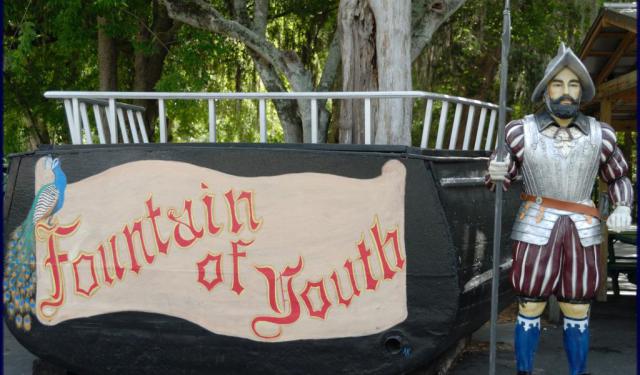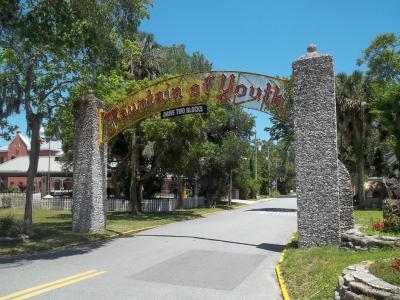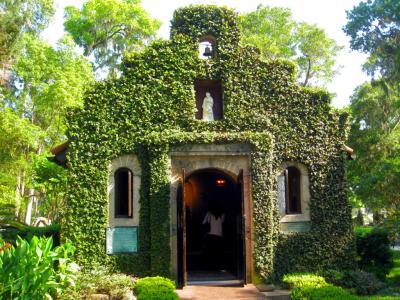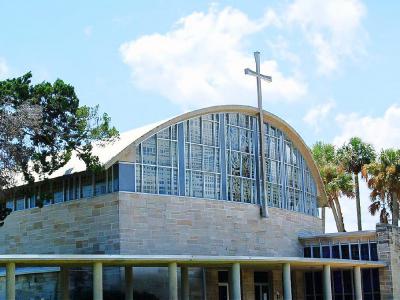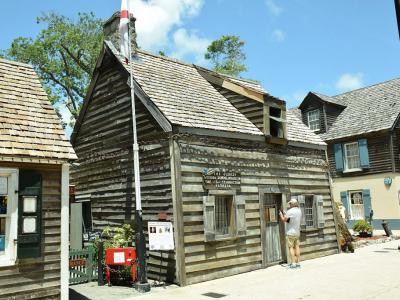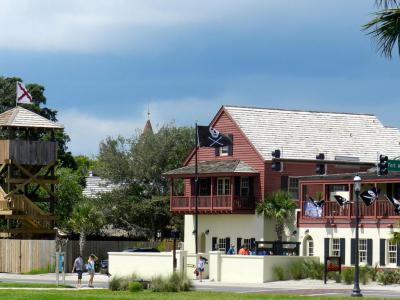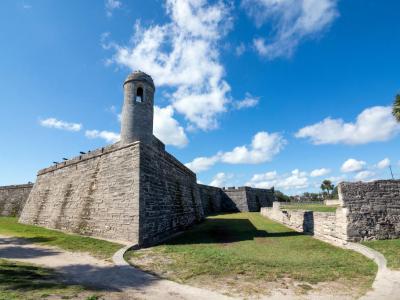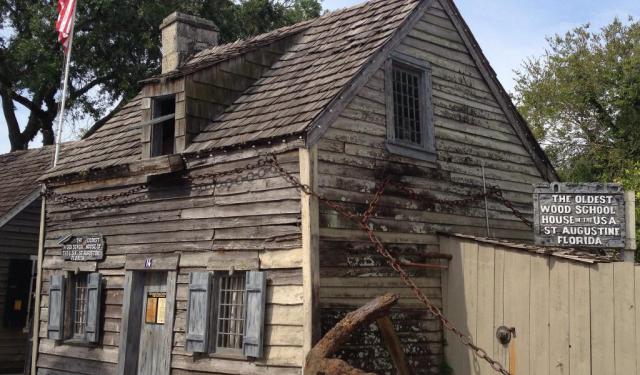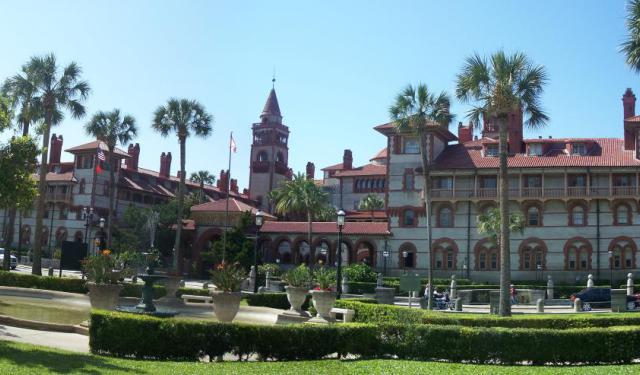St. Augustine Early Settlements Tour (Self Guided), St. Augustine
The city of St. Augustine on the northeastern coast of Florida is considered the oldest continuously occupied European settlement in the United States. It was founded by Spanish explorer Don Pedro Menendez de Aviles on September 8, 1565, and served as the capital of Spanish Florida for more than 200 years.
One of the most significant early European sites in the city is the Castillo de San Marcos (St. Mark's Castle), a fortress constructed by the Spanish in the late 1600s to defend against British and other European powers. The fortress is made of coquina, a type of limestone composed of shell fragments, and is the oldest masonry fort in the continental United States. Today, the Castillo de San Marcos is a National Monument and a popular tourist destination.
Another important early European location is the National Shrine of Our Lady of La Leche. Originally built in 1609 - in honor of a Marian apparition, popular among the Spanish settlers in the area - this is the oldest shrine in the country. Just a 4-minute walk from it lies the Fountain of Youth Archaeological Park, which is said to be the site where Spanish explorer Ponce de Leon landed in search of the legendary fountain of youth.
Other early European sites of note in the city include the Pirate and Treasure Museum, which was originally founded in Key West, in the early 2000s, and then moved to St. Augustine in 2010. The Oldest Wooden Schoolhouse, built in the early 1700s, is also a popular tourist spot and a reminder of the early days of education here.
To explore these and other locations of European heritage in St. Augustine, FL, in more detail, take this self-guided walking tour.
One of the most significant early European sites in the city is the Castillo de San Marcos (St. Mark's Castle), a fortress constructed by the Spanish in the late 1600s to defend against British and other European powers. The fortress is made of coquina, a type of limestone composed of shell fragments, and is the oldest masonry fort in the continental United States. Today, the Castillo de San Marcos is a National Monument and a popular tourist destination.
Another important early European location is the National Shrine of Our Lady of La Leche. Originally built in 1609 - in honor of a Marian apparition, popular among the Spanish settlers in the area - this is the oldest shrine in the country. Just a 4-minute walk from it lies the Fountain of Youth Archaeological Park, which is said to be the site where Spanish explorer Ponce de Leon landed in search of the legendary fountain of youth.
Other early European sites of note in the city include the Pirate and Treasure Museum, which was originally founded in Key West, in the early 2000s, and then moved to St. Augustine in 2010. The Oldest Wooden Schoolhouse, built in the early 1700s, is also a popular tourist spot and a reminder of the early days of education here.
To explore these and other locations of European heritage in St. Augustine, FL, in more detail, take this self-guided walking tour.
How it works: Download the app "GPSmyCity: Walks in 1K+ Cities" from Apple App Store or Google Play Store to your mobile phone or tablet. The app turns your mobile device into a personal tour guide and its built-in GPS navigation functions guide you from one tour stop to next. The app works offline, so no data plan is needed when traveling abroad.
St. Augustine Early Settlements Tour Map
Guide Name: St. Augustine Early Settlements Tour
Guide Location: USA » St. Augustine (See other walking tours in St. Augustine)
Guide Type: Self-guided Walking Tour (Sightseeing)
# of Attractions: 6
Tour Duration: 1 Hour(s)
Travel Distance: 2.1 Km or 1.3 Miles
Author: DanaOffice
Sight(s) Featured in This Guide:
Guide Location: USA » St. Augustine (See other walking tours in St. Augustine)
Guide Type: Self-guided Walking Tour (Sightseeing)
# of Attractions: 6
Tour Duration: 1 Hour(s)
Travel Distance: 2.1 Km or 1.3 Miles
Author: DanaOffice
Sight(s) Featured in This Guide:
- Fountain of Youth Archaeological Park
- National Shrine of Our Lady of La Leche
- Mission Nombre de Dios Museum
- Oldest Wooden Schoolhouse
- St. Augustine Pirate and Treasure Museum
- Castillo de San Marcos (St. Mark's Castle)
1) Fountain of Youth Archaeological Park
The Fountain of Youth Archaeological Park is a privately owned 15-acre park that has been said as the likely 1513 Florida landing site of Spanish explorer Ponce de Leon. The park is home to a well that is thought to be the freshwater source sought by Ponce de Leon. Archaeological excavations on the park's grounds in the 1990s uncovered remains of the first Spanish settlement and its fortifications in Saint Augustine.
The Fountain of Youth Archeological Park is the oldest continuously occupied European settlement in North America. Long before the Spanish came to La Florida, the Timucuan Indian village was established at this site for nearly 3,000 years. Archaeological excavations made by Dr. Kathleen Deagan on the park's grounds in the 1990s uncovered remains of the first Spanish settlement and its fortifications in Saint Augustine. The park also offers a variety of shows and living history reenactments designed to entertain and educate visitors. The Planetarium, the two-story Discovery Globe mapping the routes of the early explorers, the Timucuan Village, and the reconstructed First Mission of Nombre de Dios are some of the popular attractions.
The park has a deep sense of history and is a magical place that allows visitors to learn about the first Spanish settlers who came here in the 1600s and the native Timucuans who were here to greet them. The park is bursting with history, and it's a beautiful spot to relax and enjoy the views over the water from the 600-foot Founders Riverwalk or from the Observation Tower. Visitors can also sample the waters from the natural spring, which is said to be Ponce de Leon's legendary Fountain of Youth. Children can enjoy feeding the roaming peacocks.
The large grounds of the Fountain of Youth attraction make a great space for family gatherings, weddings, or other special occasions. The beautiful waterfront location offers views of the bayfront and Saint Augustine Inlet.
The Fountain of Youth Archeological Park is the oldest continuously occupied European settlement in North America. Long before the Spanish came to La Florida, the Timucuan Indian village was established at this site for nearly 3,000 years. Archaeological excavations made by Dr. Kathleen Deagan on the park's grounds in the 1990s uncovered remains of the first Spanish settlement and its fortifications in Saint Augustine. The park also offers a variety of shows and living history reenactments designed to entertain and educate visitors. The Planetarium, the two-story Discovery Globe mapping the routes of the early explorers, the Timucuan Village, and the reconstructed First Mission of Nombre de Dios are some of the popular attractions.
The park has a deep sense of history and is a magical place that allows visitors to learn about the first Spanish settlers who came here in the 1600s and the native Timucuans who were here to greet them. The park is bursting with history, and it's a beautiful spot to relax and enjoy the views over the water from the 600-foot Founders Riverwalk or from the Observation Tower. Visitors can also sample the waters from the natural spring, which is said to be Ponce de Leon's legendary Fountain of Youth. Children can enjoy feeding the roaming peacocks.
The large grounds of the Fountain of Youth attraction make a great space for family gatherings, weddings, or other special occasions. The beautiful waterfront location offers views of the bayfront and Saint Augustine Inlet.
2) National Shrine of Our Lady of La Leche
The National Shrine of Our Lady of La Leche is a historical and religious landmark. It is situated at the Nombre de Dios Mission, the site where the Spanish explorer Pedro Menéndez de Avilés and Fr Francisco López de Mendoza Grajales, OFM, celebrated the first Mass in what would become the United States. The shrine was built in 1609 in honor of the Spanish devotion to Nuestra Señora de La Leche y Buen Parto, which depicts the Blessed Virgin Mary nursing the infant Jesus.
The shrine is home to a statue of the La Leche image, the central feature of the shrine. The original shrine was destroyed by British invaders in 1728, but it was later rebuilt in 1875. The chapel, which seats about 30 people, was constructed in 1914.
Visitors to the Shrine of Our Lady of La Leche at Mission Nombre de Dios can take a walking tour of the grounds, which includes stops at various religious and historical landmarks, such as the Prince of Peace Church, the Father Lopez Statue, the Great Cross, the Mission Plaque, the Our Lady of Guadalupe Shrine, the Our Lady of Perpetual Help, Chapel of Our Lady of La Leche, and Our Lady of La Leche Shrine, and the Rustic Altar. Additionally, guests can tour archaeological excavation sites or visit the Shrine Shop.
The Shrine of Our Lady of La Leche at Mission Nombre de Dios is a popular destination for tourists and Catholics alike, as it is the oldest Marian Shrine in the United States. Parking is free, and the grounds are open daily from 9:00 a.m. to 5:00 p.m. Monday through Saturday and noon to 4:00 p.m. on Sunday, but only service animals are allowed on the grounds.
The shrine is home to a statue of the La Leche image, the central feature of the shrine. The original shrine was destroyed by British invaders in 1728, but it was later rebuilt in 1875. The chapel, which seats about 30 people, was constructed in 1914.
Visitors to the Shrine of Our Lady of La Leche at Mission Nombre de Dios can take a walking tour of the grounds, which includes stops at various religious and historical landmarks, such as the Prince of Peace Church, the Father Lopez Statue, the Great Cross, the Mission Plaque, the Our Lady of Guadalupe Shrine, the Our Lady of Perpetual Help, Chapel of Our Lady of La Leche, and Our Lady of La Leche Shrine, and the Rustic Altar. Additionally, guests can tour archaeological excavation sites or visit the Shrine Shop.
The Shrine of Our Lady of La Leche at Mission Nombre de Dios is a popular destination for tourists and Catholics alike, as it is the oldest Marian Shrine in the United States. Parking is free, and the grounds are open daily from 9:00 a.m. to 5:00 p.m. Monday through Saturday and noon to 4:00 p.m. on Sunday, but only service animals are allowed on the grounds.
3) Mission Nombre de Dios Museum
The Mission Nombre de Dios Museum is a historic site that showcases the oldest extant mission in the continental United States. Founded in 1565, the mission is a Catholic mission that is part of the Diocese of Saint Augustine. It played an important role in the early days of Florida's colonization, and was instrumental in evangelizing the native people in the region.
The museum features a wide range of exhibits that showcase the history of the mission, including the original casket of the founder of Saint Augustine, Pedro Menéndez de Avilés. Other exhibits include vestments and chalices from the Diocese of Saint Augustine's archives, artifacts found during the archaeological excavations of the mission grounds, and coquina that was part of the original foundation of the chapel. Visitors can also view reproductions of the oldest written European documents in the U.S., as well as a diorama of the first parish Mass.
One of the highlights of the mission is the National Shrine of Our Lady of La Leche, which is the oldest shrine in the region. The shrine is located on the mission grounds and is a popular destination for visitors to the area. Additionally, the Prince of Peace Votive Church was constructed in 1965 to celebrate the 400th anniversary of the mission's founding. It is made of coquina and features a large stained glass window depicting a representation of the Holy Spirit.
The grounds of Mission Nombre de Dios also include a range of other historic sites and monuments, including archaeological excavations, a historic cemetery, Marian Shrines to Our Lady of Perpetual Help and Our Lady of Guadalupe, a gift shop, a bell tower, fountains, the rustic altar, mission plaques and historical markers, monuments of the Seven Sorrows of Mary, and statues of Father López, Saint Francis of Assisi, and Saint Joseph.
With its wide range of exhibits, historic sites, and monuments, the mission offers visitors a unique glimpse into the past and a chance to learn about the early days of colonization and evangelization in the region. Best of all, admission to the museum is free, making it an accessible and affordable destination
The museum features a wide range of exhibits that showcase the history of the mission, including the original casket of the founder of Saint Augustine, Pedro Menéndez de Avilés. Other exhibits include vestments and chalices from the Diocese of Saint Augustine's archives, artifacts found during the archaeological excavations of the mission grounds, and coquina that was part of the original foundation of the chapel. Visitors can also view reproductions of the oldest written European documents in the U.S., as well as a diorama of the first parish Mass.
One of the highlights of the mission is the National Shrine of Our Lady of La Leche, which is the oldest shrine in the region. The shrine is located on the mission grounds and is a popular destination for visitors to the area. Additionally, the Prince of Peace Votive Church was constructed in 1965 to celebrate the 400th anniversary of the mission's founding. It is made of coquina and features a large stained glass window depicting a representation of the Holy Spirit.
The grounds of Mission Nombre de Dios also include a range of other historic sites and monuments, including archaeological excavations, a historic cemetery, Marian Shrines to Our Lady of Perpetual Help and Our Lady of Guadalupe, a gift shop, a bell tower, fountains, the rustic altar, mission plaques and historical markers, monuments of the Seven Sorrows of Mary, and statues of Father López, Saint Francis of Assisi, and Saint Joseph.
With its wide range of exhibits, historic sites, and monuments, the mission offers visitors a unique glimpse into the past and a chance to learn about the early days of colonization and evangelization in the region. Best of all, admission to the museum is free, making it an accessible and affordable destination
4) Oldest Wooden Schoolhouse
The Oldest Wooden Schoolhouse on St. George Street doesn’t need a fancy name-it tells you exactly what it is. Records show it on the tax rolls by 1716, making it the oldest surviving wooden school building in the country, born under Spanish colonial rule. Built from bald cypress and red cedar, fastened with hand-forged nails and wooden pegs, it doubled as both classroom and home-the schoolmaster lived upstairs while his students filled the benches below.
In 1780, Minorcan immigrant Juan Genopoly bought the property and gave it new life as both homestead and schoolroom. He and his family taught the basics-reading, writing, arithmetic, and religion-to children of Spanish settlers, Minorcan families, and others who made up St. Augustine’s diverse community. The last class graduated in 1864, and since then the little building, sometimes called the “Genopoly House,” has stood as a rare witness to colonial education in Florida.
Today, it works less as a classroom and more as a time capsule. Step inside and you’ll find the small wooden desks, old textbooks, and even animatronic students keeping the lesson alive. A detached kitchen, a modest garden, and the so-called “dungeon” for unruly pupils round out the tour. Look closely outside and you’ll see heavy iron chains, added in the 1930s to keep hurricanes from carrying the place off.
For visitors, the schoolhouse is a quick but fascinating stop-part curiosity, part museum-that brings St. Augustine’s centuries of history down to the scale of a single room where children once learned their letters.
In 1780, Minorcan immigrant Juan Genopoly bought the property and gave it new life as both homestead and schoolroom. He and his family taught the basics-reading, writing, arithmetic, and religion-to children of Spanish settlers, Minorcan families, and others who made up St. Augustine’s diverse community. The last class graduated in 1864, and since then the little building, sometimes called the “Genopoly House,” has stood as a rare witness to colonial education in Florida.
Today, it works less as a classroom and more as a time capsule. Step inside and you’ll find the small wooden desks, old textbooks, and even animatronic students keeping the lesson alive. A detached kitchen, a modest garden, and the so-called “dungeon” for unruly pupils round out the tour. Look closely outside and you’ll see heavy iron chains, added in the 1930s to keep hurricanes from carrying the place off.
For visitors, the schoolhouse is a quick but fascinating stop-part curiosity, part museum-that brings St. Augustine’s centuries of history down to the scale of a single room where children once learned their letters.
5) St. Augustine Pirate and Treasure Museum
Across the street from the stone bulk of Saint Mark's Castle sits a museum that swaps cannon fire for cutlasses-the St. Augustine Pirate and Treasure Museum. It didn’t start here; collector Pat Croce first opened it in Key West, but in 2010 it found its natural harbor in the nation’s oldest city, right where real raiders once tested Spain’s defenses. Its focus is the so-called Golden Age of Piracy, the 17th and 18th centuries, a time when the likes of Sir Francis Drake and Robert Searle were more than names in books-they were menacing the very coast of Florida. Drake even torched St. Augustine in 1586, leaving a scar that still lingers in the city’s memory.
Inside, the museum holds one of the most extensive pirate collections in the world-more than 800 artifacts ranging from navigational charts and ivory compasses to Blackbeard memorabilia. Standouts include one of the few surviving Jolly Roger flags and Captain Kidd’s heavy, iron-bound treasure chest, the last of its kind. There are also fragments from Drake’s own ship, relics that tie global seafaring drama directly back to St. Augustine’s shoreline.
The experience doesn’t stop at glass cases. Guests can fire a replica cannon, puzzle out sailor’s knots, and step into below-deck recreations that bring the smell, sound, and claustrophobic feel of ship life into sharp focus. Life-size figures, lashings, and even “guess-the-cargo-by-smell” challenges make sure the visit is more than passive observation.
By blending real artifacts with theatrical staging, the museum bridges myth and history, showing piracy’s glamour and brutality side by side. For St. Augustine, it adds another layer to the city’s story-one where empire, treasure, and violence converged on Florida’s shores. A stroll through its halls complements the nearby fortress and cathedral, rounding out the tale of how this small port stood at the edge of the world’s great rivalries.
Inside, the museum holds one of the most extensive pirate collections in the world-more than 800 artifacts ranging from navigational charts and ivory compasses to Blackbeard memorabilia. Standouts include one of the few surviving Jolly Roger flags and Captain Kidd’s heavy, iron-bound treasure chest, the last of its kind. There are also fragments from Drake’s own ship, relics that tie global seafaring drama directly back to St. Augustine’s shoreline.
The experience doesn’t stop at glass cases. Guests can fire a replica cannon, puzzle out sailor’s knots, and step into below-deck recreations that bring the smell, sound, and claustrophobic feel of ship life into sharp focus. Life-size figures, lashings, and even “guess-the-cargo-by-smell” challenges make sure the visit is more than passive observation.
By blending real artifacts with theatrical staging, the museum bridges myth and history, showing piracy’s glamour and brutality side by side. For St. Augustine, it adds another layer to the city’s story-one where empire, treasure, and violence converged on Florida’s shores. A stroll through its halls complements the nearby fortress and cathedral, rounding out the tale of how this small port stood at the edge of the world’s great rivalries.
6) Castillo de San Marcos (St. Mark's Castle) (must see)
St. Mark’s Castle rises on the waterfront as St. Augustine’s unmistakable stronghold. Its origins go back to the late 1600s, when Spain had grown tired of watching pirates and English raiders torch its wooden forts like kindling. In 1672, the crown ordered something more permanent, and for over two decades crews quarried and stacked blocks of coquina-the seashell-based limestone unique to Florida’s coast. The result was a fortress that seemed almost alive: cannonballs would sink into its walls rather than shatter them, leaving the stone pockmarked but intact. By 1695, the Castillo was finished, and for the first time St. Augustine had a defense that endured.
The centuries that followed tested those walls again and again. British sieges, pirate raids, and shifting colonial rivalries all passed, but the fort never fell. When Florida was ceded to Britain in 1763, the stronghold was renamed Fort St. Mark; two decades later it returned to Spain, and by 1821 the United States claimed it, rechristening it Fort Marion. In the 19th century it was used less as a fortress and more as a prison, including for Seminole leaders during the wars that followed U.S. expansion. By 1900 the military no longer needed it, but its stone walls remained unbroken.
Nowadays the Castle is a National Monument, its Spanish name restored in 1942. Visitors can cross the drawbridge into its sally port, walk through rooms once used as barracks or storerooms, and climb to the gun deck for sweeping views of the bay. Reenactments and exhibits explain what life was like for soldiers who kept watch here centuries ago. For nearly 350 years, the Castillo has outlasted empires and served as St. Augustine’s most enduring witness to the struggles and ambitions that shaped Florida’s coast.
The centuries that followed tested those walls again and again. British sieges, pirate raids, and shifting colonial rivalries all passed, but the fort never fell. When Florida was ceded to Britain in 1763, the stronghold was renamed Fort St. Mark; two decades later it returned to Spain, and by 1821 the United States claimed it, rechristening it Fort Marion. In the 19th century it was used less as a fortress and more as a prison, including for Seminole leaders during the wars that followed U.S. expansion. By 1900 the military no longer needed it, but its stone walls remained unbroken.
Nowadays the Castle is a National Monument, its Spanish name restored in 1942. Visitors can cross the drawbridge into its sally port, walk through rooms once used as barracks or storerooms, and climb to the gun deck for sweeping views of the bay. Reenactments and exhibits explain what life was like for soldiers who kept watch here centuries ago. For nearly 350 years, the Castillo has outlasted empires and served as St. Augustine’s most enduring witness to the struggles and ambitions that shaped Florida’s coast.
Walking Tours in St. Augustine, Florida
Create Your Own Walk in St. Augustine
Creating your own self-guided walk in St. Augustine is easy and fun. Choose the city attractions that you want to see and a walk route map will be created just for you. You can even set your hotel as the start point of the walk.
St. Augustine's Historical Houses Tour
A great deal of St. Augustine's storied past is set in stone in the form of houses that have been inhabited for over 400 years. The number of historic homes found in the city offer a glimpse into its colorful culture with European roots.
Among the most notable of them is the Ximenez-Fatio House. Built in 1798, originally as a boarding place for wealthy travelers, today this property serves... view more
Tour Duration: 1 Hour(s)
Travel Distance: 2.1 Km or 1.3 Miles
Among the most notable of them is the Ximenez-Fatio House. Built in 1798, originally as a boarding place for wealthy travelers, today this property serves... view more
Tour Duration: 1 Hour(s)
Travel Distance: 2.1 Km or 1.3 Miles
St. Augustine Introduction Walking Tour
It is said that the first-ever Thanksgiving meal took place in 1565, when Spanish explorers led by Pedro Menéndez held a Catholic Mass and a communal meal with the Timucua people in what is now St. Augustine, Florida.
Poised on Florida’s northeastern coast, the city holds the distinction of being the oldest continuously inhabited European-founded settlement in the United States. Its story... view more
Tour Duration: 2 Hour(s)
Travel Distance: 2.5 Km or 1.6 Miles
Poised on Florida’s northeastern coast, the city holds the distinction of being the oldest continuously inhabited European-founded settlement in the United States. Its story... view more
Tour Duration: 2 Hour(s)
Travel Distance: 2.5 Km or 1.6 Miles
The Most Popular Cities
/ view all
